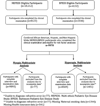Risk factors for hyperopia and myopia in preschool children the multi-ethnic pediatric eye disease and Baltimore pediatric eye disease studies
- PMID: 21856013
- PMCID: PMC3186878
- DOI: 10.1016/j.ophtha.2011.06.030
Risk factors for hyperopia and myopia in preschool children the multi-ethnic pediatric eye disease and Baltimore pediatric eye disease studies
Abstract
Purpose: To describe the risk factors associated with hyperopia and myopia among children 6 to 72 months of age.
Design: Population-based cross-sectional study.
Participants: Population-based samples of 9970 children 6 to 72 months of age from Los Angeles County, California, and Baltimore, Maryland.
Methods: Participants were preschool African-American, Hispanic, and non-Hispanic white children (n = 9770) from Los Angeles, California, and Baltimore, Maryland. Parental questionnaires and a comprehensive eye examination were administered. Demographic, behavioral, and clinical risk factors associated with hyperopia (≥2.00 diopters [D]) and myopia (≤-1.00 D) were determined.
Main outcome measures: Odds ratios (ORs) for risk factors associated with myopia and hyperopia.
Results: Compared with non-Hispanic whites, African-American (OR, 6.0) and Hispanic (OR, 3.2) children were more likely to be myopic. Children 6 to 35 months of age were more likely to be myopic compared with those 60 to 72 months of age (OR, ≥1.7). Compared with African-American children, non-Hispanic white (OR, 1.63) and Hispanic (OR, 1.49) children were more likely to be hyperopic. Children whose parents had health insurance (OR, 1.5) and those with a history of maternal smoking during pregnancy (OR, 1.4) were more likely to have hyperopia. Astigmatism of 1.5 D or more at any axis was associated with myopia (OR, 4.37) and hyperopia (OR, 1.43).
Conclusions: Children in specific racial or ethnic groups and age groups are at higher risk of having myopia and hyperopia. Cessation of maternal smoking during pregnancy may reduce the risk of hyperopia in these children. Given that both myopia and hyperopia are risk factors for the development of amblyopia and strabismus, these risk factors should be considered when developing guidelines for screening and intervention in preschool children.
Financial disclosure(s): The author(s) have no proprietary or commercial interest in any materials discussed in this article.
Copyright © 2011 American Academy of Ophthalmology. Published by Elsevier Inc. All rights reserved.
Conflict of interest statement
Figures


Comment in
-
Amblyopia refractive risk factors.Ophthalmology. 2012 Jun;119(6):1283; author reply 1283-4. doi: 10.1016/j.ophtha.2012.02.011. Ophthalmology. 2012. PMID: 22656894 No abstract available.
References
-
- Robaei D, Rose K, Ojaimi E, et al. Visual acuity and the causes of visual loss in a population-based sample of 6-year-old Australian children. Ophthalmology. 2005;112:1275–1282. - PubMed
-
- Robaei D, Huynh SC, Kifley A, Mitchell P. Correctable and non-correctable visual impairment in a population-based sample of 12-year-old Australian children. Am J Ophthalmol. 2006;142:112–118. - PubMed
-
- Werner DB, Scott WE. Amblyopia case reports--bilateral hypermetropic ametropic amblyopia. J Pediatr Ophthalmol Strabismus. 1985;22:203–205. - PubMed
Publication types
MeSH terms
Grants and funding
LinkOut - more resources
Full Text Sources

